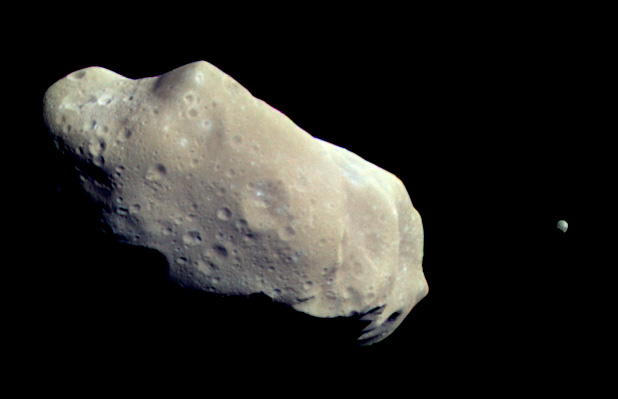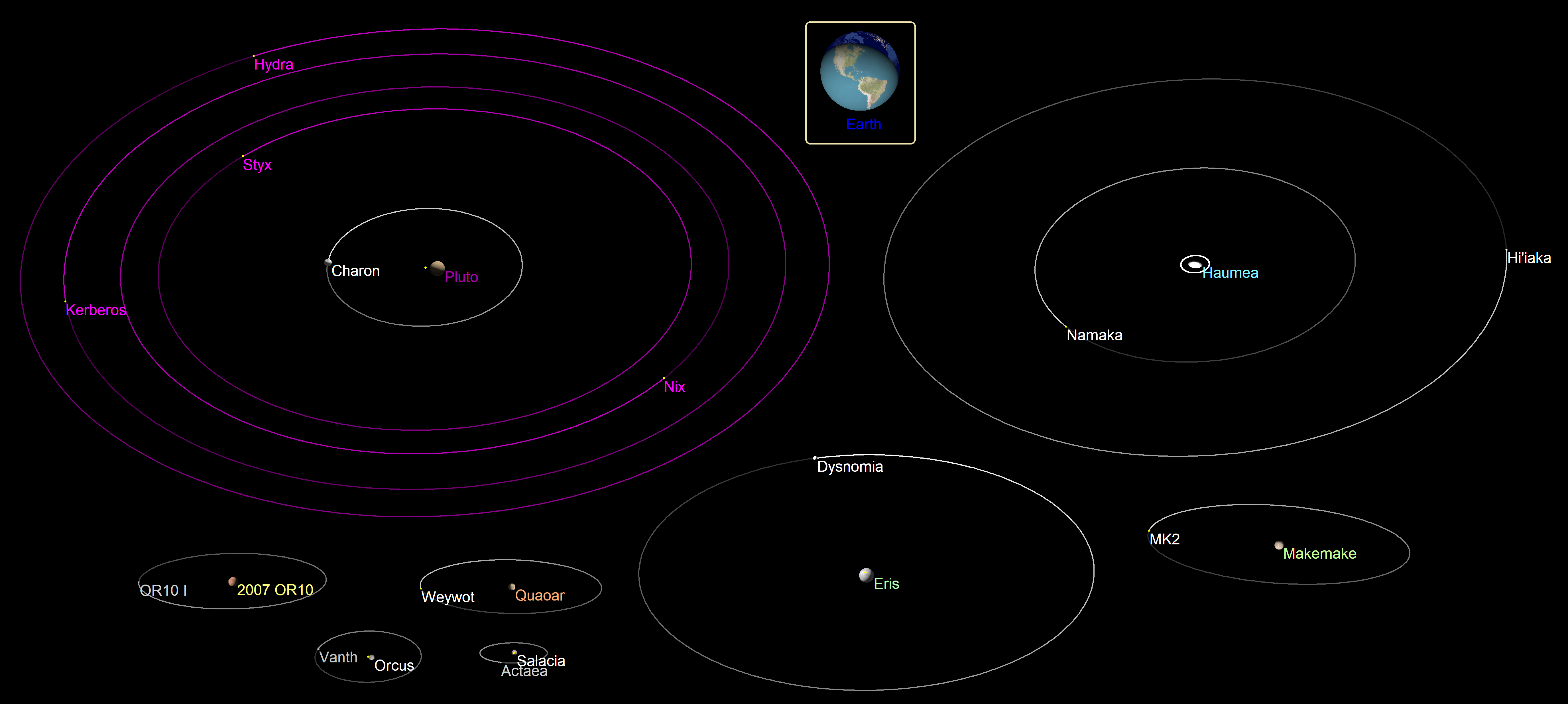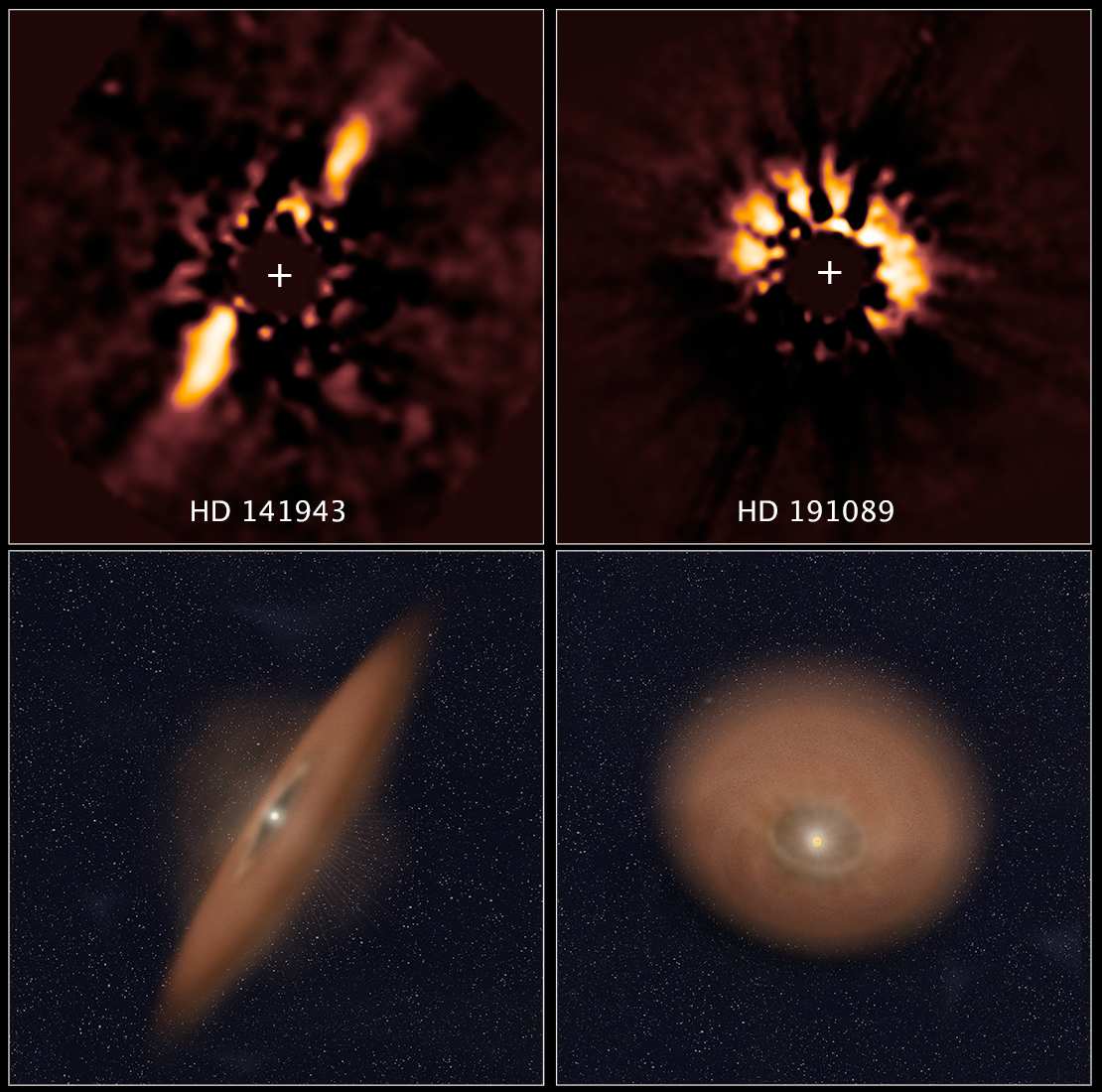|
Contact Binary (asteroid)
A contact binary is a small Solar System body, such as a minor planet or comet, that is composed of two bodies that have gravity, gravitated toward each other until they touch, resulting in a wikt:bilobate, bilobated, peanut-like overall shape. Contact binaries are distinct from true binary systems such as binary asteroids where both components are separated. The term is also used for Contact binary, stellar contact binaries. An example of a contact binary is the Kuiper belt object 486958 Arrokoth, which was imaged by the ''New Horizons'' spacecraft during its flyby in January 2019. History The existence of contact binary asteroids was first speculated by planetary scientist Allan F. Cook in 1971, who sought for potential explanations for the extremely elongated shape of the Jupiter trojan asteroid 624 Hektor, whose longest axis measures roughly across and is twice as long as its shorter axes according to light curve measurements. Astronomers William Kenneth Hartmann, William ... [...More Info...] [...Related Items...] OR: [Wikipedia] [Google] [Baidu] |
Small Solar System Bodies
A small Solar System body (SSSB) is an object in the Solar System that is neither a planet, a dwarf planet, nor a natural satellite. The term was first IAU definition of planet, defined in 2006 by the International Astronomical Union (IAU) as follows: "All other objects, except satellites, orbiting the Sun shall be referred to collectively as 'Small Solar System Bodies. (IAU) This encompasses all comets and all minor planets other than those that are dwarf planets. Thus SSSBs are: the comets; the classical asteroids, with the exception of the dwarf planet Ceres (dwarf planet), Ceres; the Trojan (astronomy), trojans; and the Centaur (minor planet), centaurs and trans-Neptunian objects, with the exception of the dwarf pla ... [...More Info...] [...Related Items...] OR: [Wikipedia] [Google] [Baidu] |
Binary Asteroid
A binary asteroid is a system of two asteroids orbiting their common barycenter. The binary nature of 243 Ida was discovered when the Galileo spacecraft flew by the asteroid in 1993. Since then numerous binary asteroids and several triple asteroids have been detected. The mass ratio of the two components – called the "primary" and "secondary" of a binary system – is an important characteristic. Most binary asteroids have a large mass ratio, i.e. a relatively small satellite in orbit around the main component. Systems with one or more small moons – also called "companions" or simply "satellites" – include 87 Sylvia, 107 Camilla and 45 Eugenia (all triples), 121 Hermione, 130 Elektra (a quadruple), 22 Kalliope, 283 Emma, 379 Huenna, 243 Ida and 4337 Arecibo (in order of decreasing primary size). Some binary systems have a mass ratio near unity, i.e., two components of similar mass. They include 90 Antiope, , an ... [...More Info...] [...Related Items...] OR: [Wikipedia] [Google] [Baidu] |
243 Ida
243 Ida is an asteroid in the Koronis family of the asteroid belt. It was discovered on 29 September 1884 by Austrian astronomer Johann Palisa at Vienna Observatory and named after Ida (nurse of Zeus), a nymph from Greek mythology. Later telescopic observations categorized Ida as an S-type asteroid, the most numerous type in the inner asteroid belt. On 28 August 1993, Ida was visited by the uncrewed ''Galileo (spacecraft), Galileo'' spacecraft while en route to Jupiter. It was the second asteroid visited by a spacecraft and the first found to have a natural satellite. Ida's orbit lies between the planets Mars and Jupiter, like all main-belt asteroids. Its orbital period is 4.84 years, and its rotation period is 4.63 hours. Ida has an average diameter of . It is irregularly shaped and elongated, apparently composed of two large objects connected together. Its surface is one of the most heavily cratered in the Solar System, featuring a wide variety of crater sizes and ages. Ida's ... [...More Info...] [...Related Items...] OR: [Wikipedia] [Google] [Baidu] |
Galileo (spacecraft)
''Galileo'' was an American robotic space probe that studied the planet Jupiter and Moons of Jupiter, its moons, as well as the asteroids 951 Gaspra, Gaspra and 243 Ida, Ida. Named after the Italian astronomer Galileo Galilei, it consisted of an orbiter and an entry probe. It was delivered into Earth orbit on October 18, 1989, by , during STS-34. ''Galileo'' arrived at Jupiter on December 7, 1995, after Gravity assist, gravitational assist flybys of Venus and Earth, and became the first spacecraft to orbit an outer planet. The Jet Propulsion Laboratory built the ''Galileo'' spacecraft and managed the Galileo project, ''Galileo'' program for NASA. West Germany's Messerschmitt-Bölkow-Blohm supplied the propulsion module. NASA's Ames Research Center managed the atmospheric probe, which was built by Hughes Aircraft Company. At launch, the orbiter and probe together had a mass of and stood tall. Spacecraft are normally stabilized either by spinning around a fixed axis or by main ... [...More Info...] [...Related Items...] OR: [Wikipedia] [Google] [Baidu] |
Minor-planet Moon
A minor-planet moon is an astronomical object that orbits a minor planet as its natural satellite. , there are 457 minor planets known or suspected to have moons. Discoveries of minor-planet moons (and binary objects, in general) are important because the determination of their orbits provides estimates on the mass and density of the primary, allowing insights into their physical properties that are generally not otherwise accessible. Several of the moons are quite large compared to their primaries: 90 Antiope, Mors–Somnus and Sila–Nunam (95%), Patroclus–Menoetius, Altjira and Lempo–Hiisi (90%, with Lempo–Paha at 50%). The largest known minor-planet moon in ''absolute'' size is Pluto's largest moon Charon, which itself has about half the diameter of Pluto. There are also several known ring systems around distant objects (see: '' Rings of Chariklo'' and ''Chiron''). Terminology In addition to the terms ''satellite'' and ''moon'', the term "binary" (binary ... [...More Info...] [...Related Items...] OR: [Wikipedia] [Google] [Baidu] |
Lagrange Points
In celestial mechanics, the Lagrange points (; also Lagrangian points or libration points) are points of equilibrium for small-mass objects under the gravitational influence of two massive orbiting bodies. Mathematically, this involves the solution of the restricted three-body problem. Normally, the two massive bodies exert an unbalanced gravitational force at a point, altering the orbit of whatever is at that point. At the Lagrange points, the gravitational forces of the two large bodies and the centrifugal force balance each other. This can make Lagrange points an excellent location for satellites, as orbit corrections, and hence fuel requirements, needed to maintain the desired orbit are kept at a minimum. For any combination of two orbital bodies, there are five Lagrange points, L1 to L5, all in the orbital plane of the two large bodies. There are five Lagrange points for the Sun–Earth system, and five ''different'' Lagrange points for the Earth–Moon system. L ... [...More Info...] [...Related Items...] OR: [Wikipedia] [Google] [Baidu] |
Planetesimals
Planetesimals () are solid objects thought to exist in protoplanetary disks and debris disks. Believed to have formed in the Solar System about 4.6 billion years ago, they aid study of its formation. Formation A widely accepted theory of planet formation, the planetesimal hypothesis of Viktor Safronov, states that planets form from cosmic dust grains that collide and stick to form ever-larger bodies. Once a body reaches around a kilometer in size, its constituent grains can attract each other directly through mutual gravity, enormously aiding further growth into moon-sized protoplanets. Smaller bodies must instead rely on Brownian motion or turbulence to cause the collisions leading to sticking. The mechanics of collisions and mechanisms of sticking are intricate. Alternatively, planetesimals may form in a very dense layer of dust grains that undergoes a collective gravitational instability in the mid-plane of a protoplanetary disk—or via the concentration and gravitatio ... [...More Info...] [...Related Items...] OR: [Wikipedia] [Google] [Baidu] |
Dale P
Dale, The Dale, Dales or The Dales may refer to: People and fictional characters * Dale (given name), a list of people and fictional characters with the given name or nickname * Dale (surname), a list of people and fictional characters * Dale Evans, stage name of American actress and singer born Frances Smith (1912–2001), wife of Roy Rogers * Dale Messick, pen name of Dalia Messick (1906-2005), ''Brenda Starr'' American comic strip artist * Dick Dale (1937-2019), Richard Anthony Monsour, American rock guitarist, ''"The King of the Surf Guitar"'' Places Terminology * Dale (landform), an open valley ** Dale (place name element) Norway * Dale, Fjaler, the administrative centre of Fjaler municipality, Vestland county * Dale, Sel, a village in Sel municipality in Innlandet county * Dale, Vaksdal, the administrative centre of Vaksdal municipality, Vestland county United Kingdom * Dale, Cumbria, England, a hamlet * Dale, Derbyshire, England, a village * Dale, Pembrokeshir ... [...More Info...] [...Related Items...] OR: [Wikipedia] [Google] [Baidu] |
William Kenneth Hartmann
William Kenneth Hartmann (born June 6, 1939) is an American planetary scientist, artist, author, and writer. He was the first to convince the scientific mainstream that the Earth had once been hit by a planet sized body ( Theia), creating both the Moon and the Earth's 23.5° tilt.'' Birth of the Planet, November 24, 2008, Channel 4 Early life and education Hartmann was born in Pennsylvania in 1939. He was awarded a Bachelor of Science degree (B.S.) in physics from Pennsylvania State University, and both a Master of Science degree (M.S.) in geology and Doctor of Philosophy (PhD) in astronomy from the University of Arizona. Career Hartmann's career spans over 40 years, from work in the early 1960s with Gerard Kuiper on Mare Orientale, and work on the Mariner 9 Mars mapping project, to work on the Mars Global Surveyor imaging team. He is currently a senior scientist at the Planetary Science Institute. He has long been one of America's leading space artists (strongly influe ... [...More Info...] [...Related Items...] OR: [Wikipedia] [Google] [Baidu] |
Astronomer
An astronomer is a scientist in the field of astronomy who focuses on a specific question or field outside the scope of Earth. Astronomers observe astronomical objects, such as stars, planets, natural satellite, moons, comets and galaxy, galaxies – in either observational astronomy, observational (by analyzing the data) or theoretical astronomy. Examples of topics or fields astronomers study include planetary science, Sun, solar astronomy, the Star formation, origin or stellar evolution, evolution of stars, or the galaxy formation and evolution, formation of galaxies. A related but distinct subject is physical cosmology, which studies the Universe as a whole. Types Astronomers typically fall under either of two main types: observational astronomy, observational and theoretical astronomy, theoretical. Observational astronomers make direct observations of Astronomical object, celestial objects and analyze the data. In contrast, theoretical astronomers create and investigate Con ... [...More Info...] [...Related Items...] OR: [Wikipedia] [Google] [Baidu] |
Light Curve
In astronomy, a light curve is a graph (discrete mathematics), graph of the Radiance, light intensity of a celestial object or region as a function of time, typically with the magnitude (astronomy), magnitude of light received on the ''y''-axis and with time on the ''x''-axis. The light is usually in a particular frequency interval or frequency band, band. Light curves can be periodic, as in the case of eclipsing binary, eclipsing binaries, Cepheid variables, other periodic variables, and Methods of detecting extrasolar planets#Transit photometry, transiting extrasolar planets; or aperiodic, like the light curve of a nova, cataclysmic variable star, supernova, gravitational microlensing, microlensing event, or binary as observed during occultation events. The study of a light curve and other observations can yield considerable information about the physical process that produces such a light curve, or constrain the physical theories about it. Variable stars Graphs of the ap ... [...More Info...] [...Related Items...] OR: [Wikipedia] [Google] [Baidu] |
624 Hektor
624 Hektor is the largest Jupiter trojan and the namesake of the Hektor family, with a highly elongated shape equivalent in volume to a sphere of approximately 225 to 250 kilometers diameter. It was discovered on 10 February 1907, by astronomer August Kopff at Heidelberg Observatory in southwest Germany, and named after the Trojan prince Hector, from Greek mythology. It has one small 12-kilometer sized satellite, Skamandrios, discovered in 2006. Description Hektor is a D-type asteroid, dark and reddish in colour. It lies in Jupiter's leading Lagrangian point, , called the Greek camp after one of the two sides in the legendary Trojan War. Hektor is named after the Trojan hero Hektor and is thus one of two trojan asteroids that is "misplaced" in the wrong camp (the other one being 617 Patroclus in the Trojan camp). Contact-binary hypothesis Hektor is one of the most elongated bodies of its size in the Solar System, being approximately 403 km in its longest ... [...More Info...] [...Related Items...] OR: [Wikipedia] [Google] [Baidu] |






